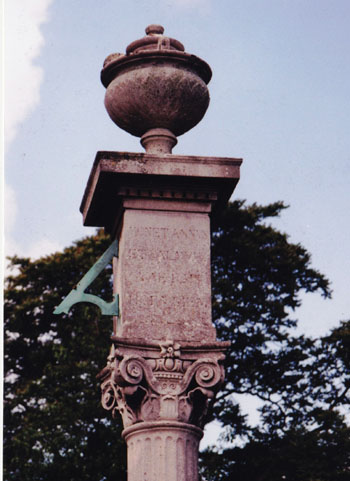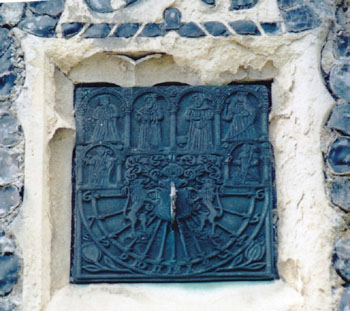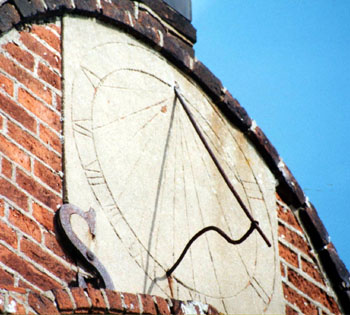Aldeburgh TM 466567
The first in the alphabetic list, Aldeburgh is an absolute must
for all sundial lovers, featuring four fine dials within a few minutes
walk. Indeed, even a local road and a residential home feature sundials
in their names. The most noted dial is on the ancient Moot Hall,
which now stands virtually on the pebble beach. Despite everything
that the elements can throw at it, the wood-and-plaster dial is
maintained in excellent condition. It is virtually south facing,
as are two of the other dials, on private houses but easily visible
from the narrow streets. One is in Oakley Square, and the other
in Dial Lane. On a small side road off the sea front is another
vertical dial which is significant in that it faces approximately
west, with the result that the shadow-casting gnomen has its origin
just off the bottom right hand corner of the dial face, rather than
the centre top as is standard for the common south facing dials.
The house which bears this dial was up for sale when the photograph
was taken, so we must hope the new owners give the dial the care
that it warrants. Aldburgh is a delightful place for a walk along
the beach, especially when the sun is shining and the fishing boats
are being dragged up the shingle. Don't forget to buy a fresh lobster,
or visit a local restaurant! |
Ashby, near Lowestoft TM 466567
This modern sundial dates from 1997. The church is Saxon, and originally
had a round  tower,
which fell down many centuries ago, and was replaced with an octagonal
tower on the base of the original. The octagonal tower has a slight
twist on it, which meant that the declination could not be estimated
from the ground. The sundial is on the southernmost face and shows
the hours from 6am to 5pm. The hour lines are formed from golden
arrows with heads and flights pointing towards the gnomon root.
The half hours are marked by the meeting points tower,
which fell down many centuries ago, and was replaced with an octagonal
tower on the base of the original. The octagonal tower has a slight
twist on it, which meant that the declination could not be estimated
from the ground. The sundial is on the southernmost face and shows
the hours from 6am to 5pm. The hour lines are formed from golden
arrows with heads and flights pointing towards the gnomon root.
The half hours are marked by the meeting points  of
the arrows, and the quarter hours by the edges of the flights. The
sundial is set on two stone corbels in flint wall. The gnomon designed
to throw a similar arrow shadow with a supporter that derives from
the initials of the donor, P Nicholson. The motto reads: “Aim higher
than the mark.” of
the arrows, and the quarter hours by the edges of the flights. The
sundial is set on two stone corbels in flint wall. The gnomon designed
to throw a similar arrow shadow with a supporter that derives from
the initials of the donor, P Nicholson. The motto reads: “Aim higher
than the mark.” |
Badingham TM305682
 The
fine 15th century church in Badingham stands on a hillside.It
is not exactly south-facing, so the sundial standing over the
gable of the flint and stone porch is set at a slight angle. This
allows it to be completely symmetrical, showing all the hours
between 6 am and 6 pm, with local noon being on the central vertical. The
fine 15th century church in Badingham stands on a hillside.It
is not exactly south-facing, so the sundial standing over the
gable of the flint and stone porch is set at a slight angle. This
allows it to be completely symmetrical, showing all the hours
between 6 am and 6 pm, with local noon being on the central vertical.
 Brandon
TL 777862 Brandon is in the north of the county, near to Thetford
and the famous "Grimes Graves", which are prehistoric flint mines.
The presence of flint is seen in St.Peter's church on the south
of the town, where there is a rare example of a direct west facing
dial on the tower. Although it is slightly cracked and weathered
- not surprising since it dates from 1725 - it carries the names
of the churchwardens, as well as the hours along the top. The
hour lines, together with those for the half- and quarter- hours,
are parallel with each other and run diagonally across the face,
which must have made it particularly easy to read in its original
state. Definitely one for an afternoon visit, if you want to see
it "in action Brandon
TL 777862 Brandon is in the north of the county, near to Thetford
and the famous "Grimes Graves", which are prehistoric flint mines.
The presence of flint is seen in St.Peter's church on the south
of the town, where there is a rare example of a direct west facing
dial on the tower. Although it is slightly cracked and weathered
- not surprising since it dates from 1725 - it carries the names
of the churchwardens, as well as the hours along the top. The
hour lines, together with those for the half- and quarter- hours,
are parallel with each other and run diagonally across the face,
which must have made it particularly easy to read in its original
state. Definitely one for an afternoon visit, if you want to see
it "in action " "
Boxford TL 963405 A very clear slate dial made by Elliott
Brothers of London is to be found on the church in Boxford, near
to Monks Eleigh and Hadleigh. Although not quite south-facing,
it is marked with the hours from 6 am to 6 pm, and shows clearly
the traditional use of the Roman IIII instead of IV. The large
15th century church also has a mass dial.
|
Bury St Edmunds TL 855640 
 The
walls of the old Abbey in Bury St Edmunds are well preserved and
the surrounding gardens are a very pleasant place to wander and
sit on the grass after a mornings shopping. Amongst the flowers
is a fine pillar dial with the column dating from 1870, although
the dial is probably significantly older. Nearby, on the side
of the cathedral, is a dial with a simple but elegant support
for the gnomen, and the common Suffolk motto of "Go about your
business" The
walls of the old Abbey in Bury St Edmunds are well preserved and
the surrounding gardens are a very pleasant place to wander and
sit on the grass after a mornings shopping. Amongst the flowers
is a fine pillar dial with the column dating from 1870, although
the dial is probably significantly older. Nearby, on the side
of the cathedral, is a dial with a simple but elegant support
for the gnomen, and the common Suffolk motto of "Go about your
business"
|
|

Clare TL 769455 The well preserved and much-photographed
18th century dial on church in Clare is another with the motto
"Go about your business", on this occasion in old English script.
It is variously ascribed to either an old Archbishop of St Edmundsbury,
or to his  gardener. gardener.
Copdock TM 121416 Now that the original A12 from London
to Ipswich has been bypassed, the old Copdock is rather off the
beaten track, and its church is a hidden oasis. This very sharply
incised dial appears at first sight to have been produced after
the death of "GR" in 1935. However, the lettering giving these
dates has been cut through the hour lines, suggesting that they
are a later addition. It could be that this is a replacement dial,
because there are reference from before the war to "an ancient
sundial".
|

East Bergholt TM 083343 East Bergholt is only just in Suffolk,
being a central part of the wonderful Constable countryside, and
sometimes being thought of as Essex. Nearby Flatford Mill is now
submerged with tourists, and East Bergholt has grown considerable,
but the old town is still pleasant. Constable met his wife in this
church, and would have seen the dial when he painted the porch.
The very clear wooden dial has now not been painted for a number
of years but its traditional shape and motto make it a classic example.
|
|

Flowton TM 085469 Flowton is just outside Ipswich, and
is home to a sundial enthusiast who has used a painted wooden
dial on the south-east side of his house as a nameplate. If you
walk round towards the church and look back towards the house
across the fields, a second dial can be seen, this time echoing
the village sign. The church itself, with sheep sometimes in the
churchyard, has at least two ancient mass dials engraved in its
walls, looking out towards Hadleigh. Look out, too, for the old
vicarage with its magnificent brick chimneys, now braced against
the roof.
Frostenden TM 479818 The dial on the church in Frostenden,
which is some way from the main road, is an example of what happens
to poorly maintained wooden dials. This one is still quite fine,
but others which were known fifty years ago have been sadly lost.
If you know of one near you, please mak e
contact and try to save it. e
contact and try to save it.
Great Barton 890660 Like many old dials, the one at Great
Barton has a rather severe Latin motto, this one reading "They
perish and are reckoned". The tomb of Sir Henry Bunbury is here,
in the town where he broke the news to Napolean that he was to
spend the remainder of his life on St. Helena. If you look carefully
at the oldest part of the church (dating from the 13th century),
a mass dial can be seen in the surround of an ancient blocked-off
doorway.
|

Great BricettTM 223511
In the charming quiet hamlet of Great Bricett, halfway between
Stowmarket and Hadleigh and not far from Wattisham airfield, is
a quaint 600 year old church with a house built onto it. In the
wall of church is a round stone with a central hole which could
be as early as Saxon. It could well have come from the remains
a nearby abbey - certainly, this place is of considerable antiquity
and the local houses have some very early woodwork both internally
and externally. Note that in this and other mass dials, the original
gnomen would have projected horizontally from the central hole,
and the hour lines are arranged to tell the times of the masses.
At this period, there was no standard clock and the hours of daylight
would have been divided into twelve equal "hours", with the result
that an hour was longer in summer than in winter.
|

Grundisburgh TM 223511 Grundisbugh (pronounced "Grunsbrr")
lies on the river Finn, which passes through the pleasant village
green. The original church is 14th century but it is the 18th century
brick tower which holds a most interesting dial. It declines significantly
towards the east, so it is best to visit it in the morning. It is
most noticeable for the extra lines and scales on its face, known
as dial furniture to aficionados. The circular scales around the
base of the gnomen can be used to tell the time at places with different
longitudes, although the particular locations are not given. The
curved diagonal lines labelled 8 through to J6 are a puzzle, though.
They are read by the shadow of the small spherical nodus about a
third of the way along the gnomen. Usually, lines like these indicate
the month of the year or the sun's declination, with the lines showing
the winter solstice at the top, the summer solstice at the bottom,
and both the spring and autumn equinoxes in the middle. In this
case there are too many lines, and the equinox line is not straight
as it should be. Altogether an intriguing, if suspicious, dial!
|

Ipswich TM 171447 It has to be admitted that the armillary
sphere in the garden of Christchurch Mansion in Ipswich's Christchurch
Park is not a particularly fine example. It is rusty and not even
properly aligned with the sun's path. Nevertheless, it does form
a good reason to visit an excellent local museum with much of interest,
and to stroll in a beautiful rolling park. Although armillary spheres
make very striking garden decorations, they are actually rather
poor as timepieces as the shadow of the rings tends to obscure that
of the central polar gnomen on its equinoctial scale. The park is
not far from St.Helen's church, which has a fine circular dial.
Sadly it has lost most of its gnomen and is rather shadowed by trees
which were probably not even planted when it was erected, but it
is still a good, simple example. Elsewhere in Ipswich, St. Nicholas'
church has another fine stone dial, this time with an iron gnomen
which is still just hanging on. |

Little Saxham TL 799638 Little Saxham, just outside Bury
St. Edmunds, has a small church with a one of the most curious round
towers in England. The dial on the south facing porch has a broken
gnomen and is of a plain but pleasant design. What most people miss,
however, is that on an east facing buttress there is the gnomen
of a much rarer direct-east dial. It looks like a simple iron strap
sticking out a few inches from the wall, but it is exactly positioned
and dimensioned to give an accurate reading of the early morning
hours before the porch dial would register. Unfortunately, the dial
face itself is now obliterated. |

Ringsfield TM 402885 This is an example of well meaning
but ignorant restoration. Ringsfield near Beccles has a well preserved
thatched church. On the old Tudor brick porch is a modern stone
dial which clearly replaces a much earlier one. The lettering is
beautifully done, and the lines look as though they have been correctly
placed. However, the crude metal gnomen is totally mispositioned.
Not only is its tip far too high (it should be in the centre of
the circle), but it has been placed vertically down the noon line
which is only appropriate for a dial facing directly south; the
slightly asymmetric hour lines show that this dial is twisted slightly
to the west. One wonders that no-one noticed that it is hopelessly
inaccurate, and probably just confirms the general misconception
the sundials can never tell the proper time. |

Thwaite TM 114682 Hidden away just off the A140, Thwaite
is a pleasant little Suffolk village. Underneath the oak vaulted
roof of the church is this ancient stone sundial which has suffered
at the hands its restorers. The replacement gnomen sticks out like
bird's perch from quite the wrong place (and wrong angle), whilst
its correct location just above has been filled with cement. The
extra circular makings above the 6 am to 6 pm line can never have
caught the sun, and must be related to the original design and layout
of the dial. |

Quidenham TM 029876 It is really cheating to include this
dial, as Quidenham is just over the border into Norfolk. However,
it is such a little gem with its figures of bishops and quaint hooded
men that it is worth stretching a point. The coat of arms seen on
this cast dial is repeated as a large woodcarving inside the church,
where it is described as the "Royal coat of arms of the Stuarts".

Witnesham TM 180509 The embattled tower on Witnesham church,
just north of Ipswich, neatly demonstrates three ages of timekeeping.
Just to the left of the door is a medieval mass dial, carefully
left exposed when the tower was later rendered. Next there is the
18th century sundial, set at an angle to the buttress to allow it
to face directly south. Finally, the octagonal clock with a single
hand, alas no longer working, covers an old window. Prior to the
war, it was reported that "from time immemorial bees have hived
behind the sundial" and, in the summer of 1996 their descendants
could still be seen flying in a steady stream into the gap at the
top of the dial. On this occasion, there was no sign of the honey
which sometimes overflows the combs into the tower. |

Woodbridge TM 276491
Elmshurst Park in Woodbridge is not far from the Deben estuary,
the famous working Tide Mill, and all the yacht building and repairing
activity around the harbour. The town, with its crowded old streets
and buildings, is one of the most pleasant in Suffolk in which
to walk. The park was presented to the town by Lord Woodbridge,
and amongst the flowers of the park is this excellent modern equatorial
dial made from stainless steel in 1988 by the local maker R S
Simon. Most sundials have only one moving part (the sun!) but
this one can be rotated bodily about its axis by the observer.
A date scale cleverly built into the stem thus allows the dial
to correct for the Equation of Time, so that the shadow may be
read directly in either British Summer Time or Greenwich Mean
Time. A plate at the base of the dial gives its latitude and also
shows south.
|

Worlingworth TM 233687 The dial on St. Mary's Church Worlingworth
is set high over the porch, which is a pity as it is rather small
and well worth studying. It is in excellent condition, especially
as it is dated 1663, and has a curious combination of both Arabic
and Roman numerals. The terse Latin motto, much favoured at that
time, warns us the "The night cometh".
|
|
 For
a full overview click
here
For
a full overview click
here  For
a full overview click
here
For
a full overview click
here